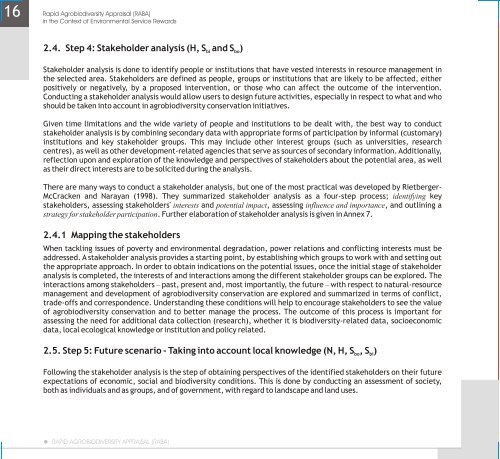Rapid Agrobiodiversity Appraisal (RABA) - Are you looking for one ...
Rapid Agrobiodiversity Appraisal (RABA) - Are you looking for one ...
Rapid Agrobiodiversity Appraisal (RABA) - Are you looking for one ...
You also want an ePaper? Increase the reach of your titles
YUMPU automatically turns print PDFs into web optimized ePapers that Google loves.
16<br />
<strong>Rapid</strong> <strong>Agrobiodiversity</strong> <strong>Appraisal</strong> (<strong>RABA</strong>)<br />
in the Context of Environmental Service Rewards<br />
2.4. Step 4: Stakeholder analysis (H, S and S )<br />
bi bo<br />
Stakeholder analysis is d<strong>one</strong> to identify people or institutions that have vested interests in resource management in<br />
the selected area. Stakeholders are defined as people, groups or institutions that are likely to be affected, either<br />
positively or negatively, by a proposed intervention, or those who can affect the outcome of the intervention.<br />
Conducting a stakeholder analysis would allow users to design future activities, especially in respect to what and who<br />
should be taken into account in agrobiodiversity conservation initiatives.<br />
Given time limitations and the wide variety of people and institutions to be dealt with, the best way to conduct<br />
stakeholder analysis is by combining secondary data with appropriate <strong>for</strong>ms of participation by in<strong>for</strong>mal (customary)<br />
institutions and key stakeholder groups. This may include other interest groups (such as universities, research<br />
centres), as well as other development-related agencies that serve as sources of secondary in<strong>for</strong>mation. Additionally,<br />
reflection upon and exploration of the knowledge and perspectives of stakeholders about the potential area, as well<br />
as their direct interests are to be solicited during the analysis.<br />
There are many ways to conduct a stakeholder analysis, but <strong>one</strong> of the most practical was developed by Rietberger-<br />
McCracken and Narayan (1998). They summarized stakeholder analysis as a four-step process; identifying key<br />
stakeholders, assessing stakeholders' interests and potential impact, assessing influence and importance, and outlining a<br />
strategy <strong>for</strong> stakeholder participation. Further elaboration of stakeholder analysis is given in Annex 7.<br />
2.4.1 Mapping the stakeholders<br />
When tackling issues of poverty and environmental degradation, power relations and conflicting interests must be<br />
addressed. A stakeholder analysis provides a starting point, by establishing which groups to work with and setting out<br />
the appropriate approach. In order to obtain indications on the potential issues, once the initial stage of stakeholder<br />
analysis is completed, the interests of and interactions among the different stakeholder groups can be explored. The<br />
interactions among stakeholders – past, present and, most importantly, the future – with respect to natural-resource<br />
management and development of agrobiodiversity conservation are explored and summarized in terms of conflict,<br />
trade-offs and correspondence. Understanding these conditions will help to encourage stakeholders to see the value<br />
of agrobiodiversity conservation and to better manage the process. The outcome of this process is important <strong>for</strong><br />
assessing the need <strong>for</strong> additional data collection (research), whether it is biodiversity-related data, socioeconomic<br />
data, local ecological knowledge or institution and policy related.<br />
2.5. Step 5: Future scenario - Taking into account local knowledge (N, H, S , S )<br />
bo bi<br />
Following the stakeholder analysis is the step of obtaining perspectives of the identified stakeholders on their future<br />
expectations of economic, social and biodiversity conditions. This is d<strong>one</strong> by conducting an assessment of society,<br />
both as individuals and as groups, and of government, with regard to landscape and land uses.<br />
RAPID AGROBIODIVERSITY APPRAISAL (<strong>RABA</strong>)

















![CynefinFramework final [Read-Only]](https://img.yumpu.com/19017304/1/190x135/cynefinframework-final-read-only.jpg?quality=85)